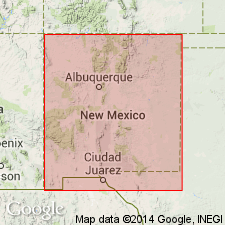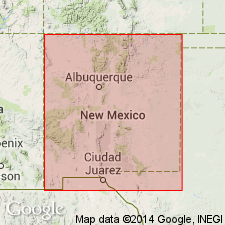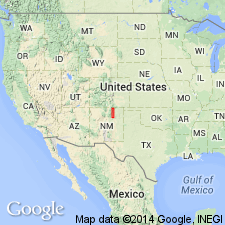
- Usage in publication:
-
- Los Esteros Member
- Modifications:
-
- Named
- Dominant lithology:
-
- Sandstone
- Mudstone
- AAPG geologic province:
-
- Palo Duro basin
Summary:
Named the middle member of three members of Santa Rosa Formation for Los Esteros Reservoir north of Santa Rosa, Guadalupe Co, NM, Palo Duro basin. Replaces term mudstone member of Santa Rosa. Type section measured in NE1/4 SE1/4 SE1/4 SE1/4 sec 3, T9N, R21E, where member is 9.4 m thick, and where member overlies Tecolotito Member (new) and underlies Tres Lagunas Member (new), both of Santa Rosa. Consists at type of basal light-gray to olive clayey sandstone that has some red-brown mottles, is quartzose, fine grained, well sorted, well rounded, and massive, that is overlain in sequence by 1) red-brown to dusky, red silty mudstone; 2) red-brown to black-red, very fine grained, well-sorted, well-rounded, moderately calcareous, massive sandstone; and 3) yellow bentonitic, calcareous mudstone. Member totals 9.4 m in thickness. Maximum thickness 44 m. Correlated with Monitor Butte Member of Chinle Formation, and with a middle part of Tecovas Formation. Assigned a Carnian, Late Triassic age. Stratigraphic charts.
Source: GNU records (USGS DDS-6; Denver GNULEX).

- Usage in publication:
-
- Los Esteros Member
- Modifications:
-
- Overview
- AAPG geologic province:
-
- Palo Duro basin
Summary:
Is the middle member of Santa Rosa Formation that has a vertebrate fauna--METOPOSAURUS sp., DESMATOSUCHUS sp., CALYPTOSUCHUS sp., Stagonolepidae POSTSUCHUS KIRKPATRIKI, a "Chatterjeea," and a new sphenosuchian--representing the oldest Late Triassic vertebrate assemblage known in the Tucumcari area, Palo Duro basin in NM. Megafossil flora has also been described from this member. Is of Late Triassic (Carnian and Norian) age. Stratigraphic chart.
Source: GNU records (USGS DDS-6; Denver GNULEX).

- Usage in publication:
-
- Los Esteros Member
- Modifications:
-
- Areal extent
- AAPG geologic province:
-
- Las Vegas-Raton basin
- Palo Duro basin
Summary:
The three members of the Santa Rosa Formation--the basal Tecolotito; middle or Los Esteros; and the upper, Tres Lagunas--can be recognized as far north as La Cueva, Mora Co, NM, Las Vegas-Raton basin. North of La Cueva, only the Tecolotito Member is thought to be present, and the Los Esteros and Tres Lagunas have pinched out. Correlation chart. Cross section. Identified in measured sections at Montezuma Gap, San Miguel Co, Palo Duro basin, and north in Mora Co at La Cueva. Many previous workers have used Santa Rosa Sandstone in report area; few place the lower and upper contacts at the same horizon. Of Late Triassic, Carnian age.
Source: GNU records (USGS DDS-6; Denver GNULEX).
For more information, please contact Nancy Stamm, Geologic Names Committee Secretary.
Asterisk (*) indicates published by U.S. Geological Survey authors.
"No current usage" (†) implies that a name has been abandoned or has fallen into disuse. Former usage and, if known, replacement name given in parentheses ( ).
Slash (/) indicates name conflicts with nomenclatural guidelines (CSN, 1933; ACSN, 1961, 1970; NACSN, 1983, 2005, 2021). May be explained within brackets ([ ]).

